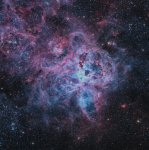jeffweiss9
Well-known member
This is more likely pilot error than a bug but I've had trouble using Pixel Math on a set of narrow band images SHO where the output of simple combinations such as 0.15*H+ 0.5*O
give completely saturated images as new image outputs. The attached file shows the PixelMath expression prior to execution and the resulting completely saturated image. This was PI v1.1.8-12 build 1531 12/29/2021 on my Win10 64b system, but I then installed the latest PI v1.1.9-1 version and got the identical result.
I've used this previously without difficulty but am stumped here.
Thanks.
give completely saturated images as new image outputs. The attached file shows the PixelMath expression prior to execution and the resulting completely saturated image. This was PI v1.1.8-12 build 1531 12/29/2021 on my Win10 64b system, but I then installed the latest PI v1.1.9-1 version and got the identical result.
I've used this previously without difficulty but am stumped here.
Thanks.

